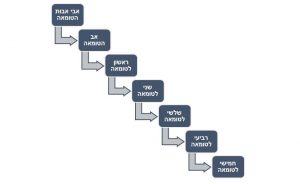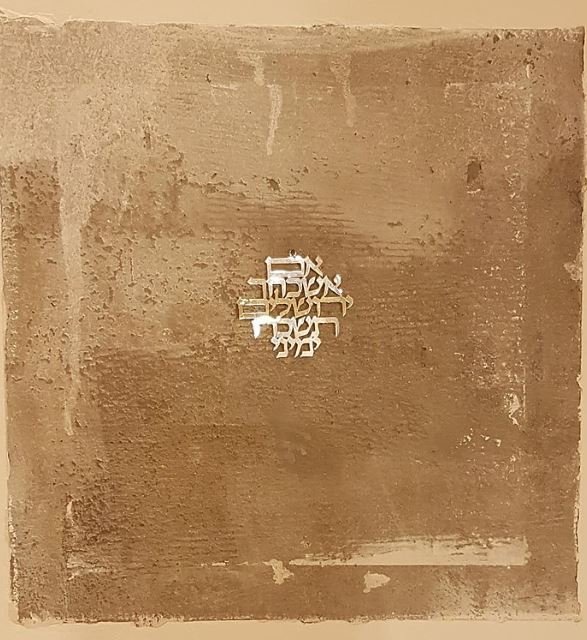General Introduction to Tuma/Tahara
Tuma/Tahara is a chok – not related to hygiene or ability to use the object/person. Usually connected to death or illness. By Torah law, tuma status only applies to Jews. A person may eat/use/touch an item that is tamei. Teruma that has become tamei may not be eaten or used.
In the words of Rav Steinsaltz: Ritual impurity is the antithesis of sanctity
A person who is tamei may not touch a consecrated object or eat it, and may not enter the Mikdash. A kohen or nazir may not become tamei met (tuma imparted by a corpse).
There are varying levels of tuma. In general, each time a person/object comes in contact with a level of tuma, (s)he/it acquires the status of one level “down” (less stringent).

- אבי אבות הטומאה (AAHT): Usually, a corpse (or significant portions[1] of it). The ultimate primary source of tuma.
If AAHT comes in contact with person or object – it becomes
- אב הטומאה (AHT) – primary source of tuma, and can transmit that tuma for 7 days.
If AHT comes in contact with an object or person – it becomes
- ראשון לטומאה (T1) First degree of tuma
If T1 comes in contact with an food or certain liquids – it becomes
- שני לטומאה (T2) – Second degree of tuma.
Tuma status of non-sacred food items ends here. However, if T2 comes in contact with teruma or sanctified food (קדשים), the teruma becomes שלשי לטומאה (T3). If consecrated food comes in contact with T3, it becomes רביעי לטומאה (T4). There is a special case of חמישי לטומאה (T5), which only applies to “Para Aduma water” (מי חטאת) cases. These (T3 through T5) are all Rabbinic in nature.
אבי אבות הטומאה (AAHT)
Usually, a corpse or significant part[2] of it
There are three entities known as AAHT:
- A corpse or a significant part of it – can never be made
- A metal utensil has a special halakha – it retains the status of AAHT[3] if it touched a corpse and does not descend one level in tuma as is usually the case[4]. It is treated like an AHT for tahara
- גולל ודופק – there are many ways to explain this. According to Rabbeinu Tam, it’s the tombstone and the stones which support it.
AAHT transmits tuma via:
- Contact טומאת מגע
- Being carried טומאת משא
- In a tent טומאת אוהל (halakha is that this only applies to Jewish corpse)
Tumat Ohel:
- The structure has to be one cubic tefach in volume
- Contains a corpse or majority part of it
- Any item capable of acquiring tuma that is in that space becomes AHT and can make people and vessels tamei.
- The structure also serves as a barrier to shield people and objects outside it from tuma.
- The barrier upwards only works if there is at least a tefach between the corpse and the covering. If less than a tefach, it’s טומאה רצוצה (squashed) and extends upward indefinitely.
Rabbinic Laws:
- בית הפרס – an area that has been plowed and there is uncertainty if there is a grave/corpse in the location
- מדור גויים – place where non Jews live is considered tamei (concern that aborted fetus was buried there) and transmits tuma
- ארץ העמים – Land outside Israel (contact with the land or entering its airspace makes you tamei)
- טומאה בחיבורים – chain of contact. If a line of people are touching each other and one comes in contact with a corpse, they all become tamei
אב הטומאה (AHT)
The most “severe” category
Transmits tuma to people and vessels, which become T1, except for a metal utensil (as noted above), which does not descend a level and is a AHT[5].
- A person or object that came in contact with AAHT, or was in a structure with a corpse or carried it (even without direct contact). Purification is effected through the para aduma process[6]
- Creeping animals (the carcass of any of the שמונה שרצים listed in Vayikra 11:29-30:
| וְזֶה לָכֶם הַטָּמֵא בַּשֶּׁרֶץ הַשֹּׁרֵץ עַל־הָאָרֶץ הַחֹלֶד וְהָעַכְבָּר וְהַצָּב לְמִינֵהוּ׃ וְהָאֲנָקָה וְהַכֹּחַ וְהַלְּטָאָה וְהַחֹמֶט וְהַתִּנְשָׁמֶת׃ The following shall be unclean for you from among the things that swarm on the earth: the mole, the mouse, and great lizards of every variety; the gecko, the land crocodile, the lizard, the sand lizard, and the chameleon. |
- The only carcasses of any creeping animals that impart tuma on contact
- Smallest size that imparts tuma is the size of a lentil
- There is no way to make this tahor
- The carcass of an unslaughtered animal טומאת נבלה (at least the size of a kzayit) whether kosher or non-kosher species. If the animal was slaughtered correctly, but found to be defective, it is not considered a נבלה for purposes of tuma. Different rules for carcasses of unslaughtered kosher birds.
- Imparts tuma to person or vessels by contact and to a person who carries it (even if not directly touching)
- Clothes of person carrying/touching also become tamei
- Tuma lasts one day טומאת ערב (need sunset and mikve – which can be during the day)
- Semen
- Whether voluntary or involuntary
- Whether in the context of sexual relations or not
- Tamei until nightfall; immerses during the day
- A leper (as well as leprous house/clothes)
- Leper has a special purification process once cured (see Vayikra 14), which takes 7 days to complete and involves special rituals.
- House with four walls built of stone, wood or mud
- Garments of undyed leather, wool or linen
- The water mixed with the ashes of the para aduma (מי חטאת). The ones involved in its preparation become T1
- A menstruating woman נידה
- By Torah law, she is tamei for 7 days after the onset of menstrual bleeding and can immerse in a mikve and become tahor on the eighth day (even if she bled all 7 days)
- From the Talmudic times, women adopted a stringency and wait seven days without uterine bleeding before immersion
- Until immersion, she Imparts tuma to people/vessels by:
- Contact
- Being moved by them
- By moving them (even if not in actual contact with item)
- Lying/sitting on them
- Leaning/hanging on them
- Through a heavy immovable stone אבן מסטאover them
- Someone who had relations with a menstruating woman בועל נידה
- Becomes tamei for 7 days
- Makes objects upon which he lies T1 (not AHT)
- A woman after childbirth יולדת
- By Torah law, refers to vaginal birth
- After birth of a boy – 7 days; girl – 14 days, she is tamei
- Goes to mikve and then is tahor for 33/66 days even if she experiences bleeding ( דם טוהר)
- During the 40/80 days after birth she can’t enter Mikdash or eat consecrated food.
- After 40/80 days she brings a korban and can enter Mikdash and eat consecrated food.
- Imparts tuma to people/vessels by:
- Contact
- Being moved by them
- By moving them (even if not in actual contact with item)
- Lying/sitting on them
- Leaning on them
- Through a heavy immovable stone אבן מסטאover them (stone itself does not become tamei)
- A zav (man with a seminal discharge without an erection: gonorrhea?) – see Vayikra 15
- If he experiences it on one occasion, he’s tamei for one day (like a person who had a seminal emission)
- If he experiences a second discharge on same or following day, or if initial discharge is prolonged, he’s considered a zav and his tuma lasts 7 days שבעה נקיים
- If he has a third emission during the next 24 hours, he needs to bring a korban
- Imparts tuma to people/vessels by:
- Contact
- Being moved by them
- By moving them (even if not in actual contact with item)
- Lying/sitting on them
- Leaning on them
- Through a heavy immovable stone אבן מסטאover them
- His spittle, urine and semen transmit tuma. Other fluids (blood or tears) are T1; some others (sweat) are not tamei at all.
- If he sits or lies on a surface designated for that purpose, the surface becomes a AHT.
- A zava (woman with vaginal bleeding on three consecutive days during time when she does not expect to menstruate)
- First sighting makes her tamei BUT she is not yet subject to the zava regulations until the third sighting.
- Until then, she is שומרת יום כנגד יום – observing a day for a day.
- May not engage in relations
- By Torah law- she only has to wait until a day has passed (“a day for a day”) without blood and then she goes to mikve
- If she bleeds on the third day, she is a zava
- Needs seven “clean” days
- Brings korban as part of tahara process
- Imparts tuma as a zav does
- A man who has sexual relations with her becomes AHT and can transmit tuma to others
- Women have adopted the stringencies of zava as part of taharat hamishpacha practices
- An article upon which a zav or zava sits or lies
- BY RABBINIC DEGREE: an idol or statue used for worship, its accessories, the remains of idolatrous sacrifices and the remains of idolatrous libations.
Secondary sources of Tuma: ולד הטומאה
Something that came in contact with an AHT
Becomes tamei and may be able to transmit tuma to food or liquids it comes into contact with. Does not transmit tuma to people or vessels.
- ראשון לטומאה (T1): A person or non-metal object that came in contact with AHT.
- Food that comes in contact with T1 becomes T2.
- Rabbinic degree that liquids that come in contact with T1 or even T2 become T1.
- Remediated by immersion in mikve and waiting until sunset.
- Metal object that came in contact with human T1 becomes T1
- Those who are involved in creating מי חאטת (para aduma water). The kohen who throws the animal on the fire, burns it, gathers the ashes, or carries the water becomes tamei as do his clothes. The person who touches the water becomes tamei but his clothes do not. The kohen who sprinkles the water remains
- שני לטומאה (T2): Food that came into contact with T1. If it is non-sanctified, it is considered disqualified (פסול).
- The tuma “chain” stops here for non-sanctified foods.
- A liquid that comes in contact with T2 becomes T1 (rabbinic decree).
- Rabbis also decreed that certain items (e.g., holy books and unwashed hands) have T2 status
- Hands:
- Based on presumption that hands are constantly in use and people are not careful
- Are remediated by ritual washing
- Holy books:
- People would store teruma with holy books, and vermin would gnaw at the books
- Discourage unnecessary contact
- שלישי לטומאה (T3): Food that came in contact with T2.
- Only applies to teruma and consecrated foods.
- Teruma that is T3 is פסול but only transmits tuma to consecrated foods
- רביעי לטומאה (T4): Consecrated food that came in contact with T3.
- חמישי לטומאה (T5): Only applies to contact with מי חטאת (“para aduma water”).
- Hands:
Remediation of Tuma
There are three basic categories of remediation:
- טומאת ערב – Tuma lasts one day. A person who contracted that type of tuma immerses in a mikve during the day and waits until nightfall, when s/he is considered tahor.
- טבול יום – someone who has immersed in the mikve but is waiting for nightfall (הערב שמש) : some restrictions are removed before nightfall. For example, s/he may eat מעשר שני
- טומאת שבעה – Tuma lasts seven days
- מחסור כפרה – certain types of tuma require korbanot as part of the tahara Until those korbanot are brought, s/he may not enter the Mikdash or eat from korbanot.
Tuma of Utensils
A utensil is any man-made, moveable object designed to be purposefully used. Includes clothes, boxes, tools, mats, etc. DOES NOT include food, plants, animals, rocks, etc. or buildings. Object must be a finished product
Various susceptibility to tuma (discussed in masechet Keilim). Some are always susceptible, some are never, and some are occasionally susceptible, depending on specific circumstances.
- Never susceptible:
- Unfinished vessels
- Vessels attached to the ground
- Vessels too large to move
- Utensils only used by animals
- Vessels made of:
- Stone
- Dung
- Remains of marine creatures
| Material | Type | Fixed by | If broken | If repaired |
| Metal | All | Immersion | Lose tuma status | Regain tuma status |
| Glass | None by Torah law | Immersion (Rabbinic) | ||
| Earthenware | – Only inside becomes tamei (as soon as source of tuma enters internal airspace – no contact needed) – Only concave vessels (not flat) – If there is a cover, it is not susceptible to tuma צמיד פתיל | Need to make a hole in its underside or side that is large enough to make it ineffective as a receptacle.
| Lose tuma status שבירתן היא טהרתן | Retain tahor status |
| Wood | – Only concave vessels – Smaller than 40 se’a (Rabbi decreed that certain flat wooden vessels acquire tuma) | Immersion | Lose tuma status | |
| Cloth | Must be 3×3 fingerbreadths wide | Immersion |
Tuma of Food
Depends on level of sanctity of food – can become T1 through T4. Never is a AHT. Food can only transmit tuma to a person if s/he eats it. Cannot transmit tuma to other foods BUT can transmit to liquids. Needs to be at least the size of an egg to transmit tuma. Some authorities say it cannot become tamei unless at least the size of an egg.
הכשר טומאה Becoming susceptible to tuma: (see Vayiqra 11):
- Severed from its place of growth
- Comes in contact with one of the “seven liquids”
- By direct action of owner OR
- With owner’s approval
- 7 liquids[7] יד שחט דם
- Water
- Wine
- Honey
- Olive oil
- Milk
- Dew
- Blood
- Rabbis decreed that meat of sacrifices does not need contact with liquid to become tamei
- Blood of animals slaughtered in the Mikdash and the water used there (and possibly the wine and oil) do not render food susceptible to tuma and do not themselves become tamei.
- Status of inedible part of food is subject of much discussion
- Liquids that come in contact with T1 or T2 become T1 (Rabbinic degree)
[1] Kezayit of the body or a reviit of blood
[2] See note 1
[3] If it touched a person who touched a corpse, it becomes AHT
[4] This case is known as כלי מתכת כיוצא בו
[5] If this metal utensil touches another one, that utensil become T1
[6] Count seven days, sprinkle with מי חטאת on the 3rd and 7th days, immerse in mikve on 7th day and is tahor after sunset.
[7] Here’s a Pesach connection: what do we do at the Seder that is connected to this law?











